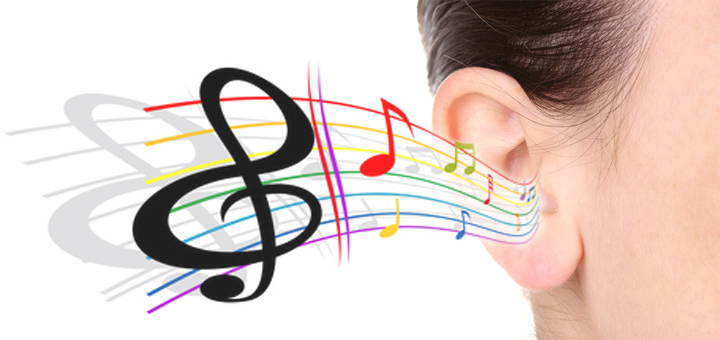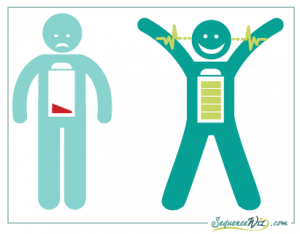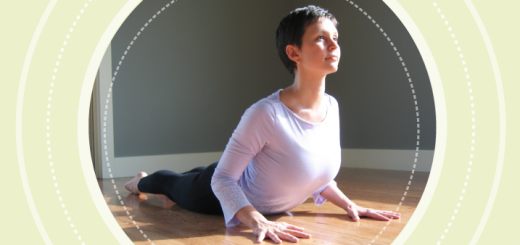Vagus nerve and sound: Can you “tone up” the whole body?
5 You don’t need to be a scientist to know that sound (music and singing) has a profound effect on the way we feel, often in a predictable way. For example, you probably won’t fall asleep when you listen to a marching band, nor would you jump wildly around the room when you listen to a lullaby. Yet the exact mechanism of how and why sound affects us in certain ways is not exactly clear (although there are many theories).
You don’t need to be a scientist to know that sound (music and singing) has a profound effect on the way we feel, often in a predictable way. For example, you probably won’t fall asleep when you listen to a marching band, nor would you jump wildly around the room when you listen to a lullaby. Yet the exact mechanism of how and why sound affects us in certain ways is not exactly clear (although there are many theories).
We know that the ear transmits energy from sound waves. Sound travels through the inner ear as vibrational energy until it reaches the cells of Corti (a receptor organ deep in the ear) where it becomes an electrical nerve message that travels from these cells along the 8th cranial nerve to the cortex of the brain for final interpretation of the sound.
In fact, the ear has been called “the Rome of the body” (as in “All roads lead to Rome”) because of the fact that almost all cranial nerves lead to the ear, including the vagus nerve. “Let us track the path of the vagus throughout the body. The nerve wanders on from its liaison with the ear, next making contact with back muscles; it then sensitizes the larynx which allows us to speak, sing, or scream. The vagus then travels to the lungs and heart before diving through the diaphragm to innervate all of our internal organs (including the entire intestinal tract via communication with sacral nerves). Hearing has substantial effects on the rest of the body due to its contact with the vagus nerve.” (1) Just think of the suspenseful soundtrack in the last thriller you watched – do you remember how it affected your breathing and heart rate?
One theory that explains the effect that sound has on our physiology was proposed by French otolaryngologist Alfred A. Tomatis. He believed that the primary function of the ear is to provide the cells of the body with electrical stimulation or cortical charge.  He believed that once the nervous impulses generated by the cells of Corti reach the brain, they get distributed throughout the body “toning up the whole system and imparting greater dynamism to the human being” (Tomatis. 1978). He didn’t say specifically that the distribution happens through the vagus nerve, but it seems likely. He stated that different sounds have different effects on cortical charge. The cells of Corti respond much more intensely to high-frequency sound than to low-frequency sound. He calls sounds rich in high harmonics “charging sounds,” in contrast to sounds rich in lower tones, which he calls “dis-charging sounds.”
He believed that once the nervous impulses generated by the cells of Corti reach the brain, they get distributed throughout the body “toning up the whole system and imparting greater dynamism to the human being” (Tomatis. 1978). He didn’t say specifically that the distribution happens through the vagus nerve, but it seems likely. He stated that different sounds have different effects on cortical charge. The cells of Corti respond much more intensely to high-frequency sound than to low-frequency sound. He calls sounds rich in high harmonics “charging sounds,” in contrast to sounds rich in lower tones, which he calls “dis-charging sounds.”
Dr. Tomatis used those principles in his high-frequency sound therapy and claimed that “charging sounds” manifested in increased motivation and competence in work, better concentration, increased memory skills, lower susceptibility to fatigue, and generally more dynamism and energy (Tomatis, 1978). In his clinical practice, he claimed to have successfully treated a wide range of illnesses including hearing and voice loss, stuttering, ringing in the ears, depression, attention deficit disorder, hyperactivity, dyslexia, inability to concentrate, and a variety of balance/coordination disorders related to problems with the inner ear.
The traditional medical establishment in France always considered Tomatis’ sound therapy an alternative medicine and didn’t endorse it. However, the latest studies confirm some of his findings. For example, one study suggests that the Tomatis Method has positive effects in children with ADD. “Results revealed statistically significant improvements for the Tomatis when compared to the non-Tomatis group: the experimental group showed significant improvement in processing speed, phonological awareness, phonemic decoding efficiency when reading, behavior, and auditory attention.” (2)
And Dr. Tomatis was endorsed by Sting, too! 🙂 (3)
Regardless of what one might think of Dr. Tomatis’ methodology, his theory of the charging and discharging sounds strongly correlates with the brhmana/ langhana idea that is important in both yogic and Ayurvedic traditions. The Brhmana / Langhana model states that there are two kinds of practices: those that nourish and build the system (brhmana, also spelled brmhana) and those that reduce or eliminate from the system (langhana). So you choose one or the other depending on what it is you are trying to accomplish. If you got too much of a certain kind of energy (anxiety, agitation, anger, etc.) or got too little (low energy, low self-esteem, depression, etc), it will be harder for you to find the state of internal equilibrium. So what do you do? You get rid of the excess and build on deficiencies!
There are certain kinds of practices in yoga that have a pronounced langhana effect and others that have more brhmana effect. Sound has traditionally been an essential component of the yoga practice. When it comes to sound, two qualities define whether it will have a brhmana or langhana effect – svara (pitch) and balam (strength).
Svara: Lower pitch sounds will have a more pronounced langhana effect, and higher pitch sounds will have a more brhmana effect (which is similar to what Dr. Tomatis was saying). However, if the pitch is too high or too low it will produce agitation.
Balam: The stronger the sound (including volume), the more brhmana effect it will have. Softer sounds have more langhana effect.
So using Dr. Tomatis’ terminology we might call brhmana sounds (stronger with higher pitch) “charging” and langhana sounds (softer with lower pitch) “dis-charging.”
It might be tempting to equate the brhmana/langhana model to sympathetic/parasympathetic activation, but they are not exactly the same. The biggest difference worth noting is that the brhmana state does not mean “fight-or-flight mode”, but more of a “refreshed-and-awakened” mode. That is why chanting is widely used in many spiritual traditions as a way to stay present, focused, and energized. Next, let’s talk about the effect that making sounds has on your physiology >





















As a kirtan leader and jazz singer (not professionally any more) this is wonderful research to read about! More reason for more beautiful music in our day.
When I was working in bands, there were nights it “swung” and it was a unifying inexplicable force. Sounds a bit like the divine.
Thank you, I’m sharing.
I wholeheartedly agree with Beth, and thanks so much for sharing your knowledge and wisdom, Olga! Creating a beautiful day your way… with love, Suzanne
I’m baffled by your statement ” almost all cranial nerves lead to ear”. The only cranial nerve that “leads to the ear” is the vestibulocochlear nerve and it is sensory only, carrying signals away from the ear. The statement that most cranial nerves lead to the ear does not seem to be anatomically correct. Please correct me if I’m wrong, but tell me which of the 11 pairs of cranial nerves lead to the ear. I’m aware of only 3. There is 1) an auricular branch of the vagus that goes to the skin of the ear canal, and 2) a tympanic branch of the glossopharyngeal that goes to the middle ear, and finally 3) an auricular branch of the facial nerve that controls scalp muscles around the ear. So that is only 3 of the 11 other cranial nerves that have something to do with the ear, but none of them are directly involved with the sound impulses created by the organ of Corti. Please reply.
Hi Don, thank you for your comment! This statement was based on an article by Bradford S. Weeks, MD The physician, the Ear and Sacred Music. Here is the exact quote: “As a student of gross anatomy, I was struck by the fact that almost all cranial nerves lead to the ear. Cranial nerves 2-11 are either directly connected with other nerves or indirectly linked with them via branching. In order to appreciate fully the many varied roles of the acoustic or 8th cranial nerve, one must understand its link to the function of vision. It is customary when dealing with brain functions to link eye, head and neck mobility with the optic nerve. However, these functions are also under control of the acoustic nerve.” Is this incorrect? I am always open to learning more specifics!
My husband had a noise injury directly to his right ear 4 years ago and has suffered horrible dizziness, detached feeling, tinnitus, migraines, nausea, and shooting ear pain all at the right ear ever since. During a myofascial release session he was told his 4 or 5 cranial nerve is the problem. Any thoughts on this? Recommendations for treating this? He had a neurologist tell him to look into sound therapy, why I am looking!